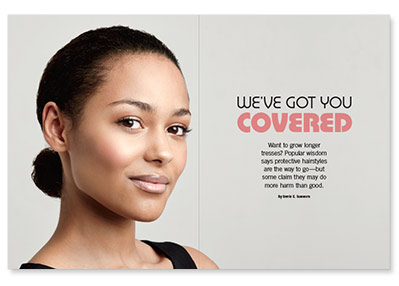
Thanks to the fragile nature of our hair, black women sometimes go to great lengths, so to speak, to retain longer locks and prevent breakage. Many would agree that protective styles succeed at both.
Protective styles are coifs that safeguard the ends of the hair and reduce the need to manipulate tresses using heat and chemicals that can lead to tangles and breakage. Also, many women turn to protective styles after undergoing the “big chop” when they transition from relaxed hair to natural.
While these protective styles will not directly stimulate hair growth, these low-maintenance looks can help keep our strands from snapping off because of too much handling.
Still, there is some debate, especially in the natural hair community, as to whether protective styles may do more harm than good. Why? Well, because even these types of styles can become a problem if the wearer thinks low maintenance means no maintenance.
For example, certain protective styles, such as braids, can take a long time to create and take out. As a result, women who wear braids might tend to leave the style in too long. What’s more, elaborate braided styles can cause tension and also lead to damage, depending on the technique the hairstylist uses to create them. The same can be said about extensions and weaves, which can also damage the hair more so than regular styling.
In addition, braided or cornrowed styles can make it difficult to keep the hair roots moisturized and the scalp clean. That’s because these areas are hard to access during shampooing. Also, our ends are tucked away when tresses are styled in this way, so thirsty strands can become dry and brittle. And if you wash the hair infrequently to avoid disturbing braided styles, you risk product buildup. (This means if you have a scalp condition that requires frequent washing with medicated shampoos or treatments, it’s best to avoid styles that are left in for a long period of time.)
To sum up, the point of low-maintenance hairstyles such as braids, twists and even weaves and wigs, is to protect the fragile ends of our hair from the environment. This means sheltering our strands from extreme temperatures and moisture-robbing winds in the summer and winter and reducing heat styling, combing and brushing.
To make sure that protective and low-maintenance hairstyles actually protect the hair, observe the following hair rules:
Moisturize.
Use water-based moisturizers, gels and light oils after washing or when styling.
Detangle.
When working with natural tresses or hair that easily tangles, remove or prevent knots while the hair is damp, or saturate it with moisturizers and oils. Also, avoid alcohol-based gels at all cost because these can dry out the hair. To minimize tangling, use your fingers to detangle the hair, or try a wide-tooth comb with smooth teeth to avoid snags.
Condition.
Just one rule here: Regularly use a deep conditioner on your hair.
Chose the right products and styles.
The low-maintenance styles and products that are best for your hair will depend on the texture, curl pattern and health of your hair. For example, don’t use heavy products on thin hair. Also, wash-and-go styles might be better for thin and wavy hair, but the same might tangle thick, coarse hair.
Wash and condition the hair before styling.
After washing the hair, moisturize, section and twist, or braid, tresses. Leave the braids or twists in for a few days, which can double as a hairstyle. Once the braids or twists are taken out, the twist-out or braid-out provides a low-maintenance style. To reduce boredom (another complaint about wearing protective styles), you can transform the twists or braids into buns or updos.
Still don’t have a clue? Check out videos and websites on the Internet that feature interesting protective styles and directions on how to achieve them.






1 Comment
1 Comment